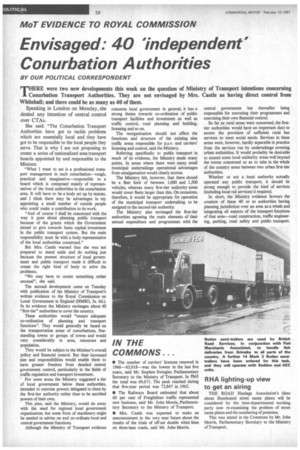Envisaged: 40 independent' Conurbation Authorities
Page 30

If you've noticed an error in this article please click here to report it so we can fix it.
BY OUR POLITICAL CORRESPONDENT THERE were two new developments this week on the question of Ministry of Transport intentions concerning 1 Conurbation Transport Authorities. They are not envisaged by Mrs. Castle as having direct control from Whitehall; and there could be as many as 40 of them.
Speaking in London on Monday, she denied any intention of central control over CTAs.
She said: "The Conurbation Transport Authorities have got to tackle problems which are essentially local and they have got to be responsible to the local people they serve. That is why I am not proposing to create a series of nationalized area transport boards appointed by and responsible to the Minister.
"What I want to see is a professional transport management in each conurbation—tough, practical and imaginative—responsible to a board winch is composed mainly of representatives of the local authorities in the conurbation area. It will have to be a body set up by statute, and I think there may be advantages in my appointing a small number of outside people who could make a contribution to its work.
"And of course I shall be concerned with the way it goes about planning public transport because of the grants which the Government intend to give towards basic capital investment in the public transport system. But the main responsibility must lie with a body representative of the local authorities concerned."
But Mrs. Castle warned that she was not prepared to stand aside and do nothing just because the present structure of local government and public transport made it difficult to create the right kind of body to solve the problems.
"We may have to create something rather unusual", she said.
The second development came on Tuesday with publication of the Ministry of Transport's written evidence to the Royal Commission on Local Government in England (HMSO, 3s. 6d.). In its evidence the Ministry envisages about 40 "first-tier" authorities to cover the country.
These authorities would "ensure adequate co-ordination of planning and transport functions". They would generally be based on the transportation areas of conurbations, freestanding towns or groups of towns and would vary considerably in area, resources and population.
They would be subject to the Minister's overall policy and financial control. But their increased size and responsibilities would enable them to have greater freedom from detailed central government control, particularly in the fields of traffic regulation and transport investment.
For some areas the Ministry suggested a tier of local government below these authorities, intended to exercise powers delegated to them by the first-tier authority rather than to be ascribed powers of their own.
This plan, said the Ministry, would do away with the need for regional local government organization; but some form of machinery might be needed to advise on and co-ordinate local and central government functions.
Although the Ministry of Transport evidence concerns local government in general, it has a strong theme towards co-ordination of public transport facilities and investment as well as traffic control, road planning and building, licensing and so on.
The reorganization should not affect the functions and structure of the existing nine traffic areas responsible for p.s.v. and carriers' licensing and control, said the Ministry.
Referring specifically to public transport in much of its evidence, the Ministry made many points. In areas where there were many small municipal undertakings operational advantages from amalgamation would clearly accrue.
The Ministry felt, however, that there should be a fleet limit of between 1,000 and 1,500 vehicles, whereas many first-tier authority areas would cover fleets larger than this. On occasions, therefore, it would be appropriate for operation of the municipal transport undertaking to be assigned to the second-tier authority.
The Ministry also envisaged the first-tier authorities agreeing the main elements of their annual expenditure and programmes with the central government but thereafter being responsible for executing their programmes and exercising their own financial control.
So far as rural areas were concerned, the firsttier authorities would have an important duty to secure the provision of sufficient rural bus services to meet social needs. Services in these areas were, however, hardly separable in practice from the services run by undertakings covering urban authorities. It would probably be desirable to extend some local authority areas well beyond the towns concerned so as to take in the whole of the country areas between two urban first-tier authorities.
Whether or not a local authority actually operated any public transport, it should be strong enough to provide the kind of services (including local rail services) it required.
In short, the Ministry evidence favours the creation of these 40 or so authorities having planning jurisdiction over an area as a whole and integrating all aspects of the transport functions of that area—road construction, traffic engineering, parking, road safety and public transport.












































































































